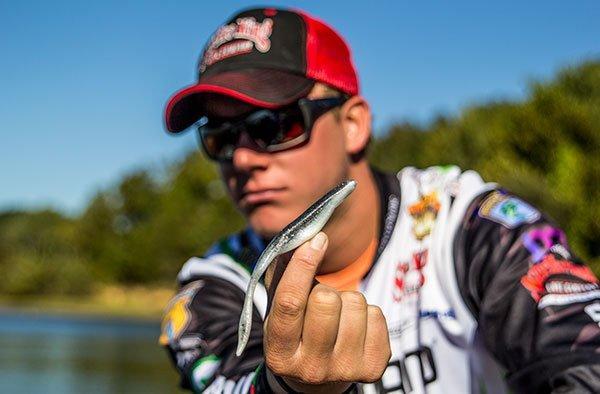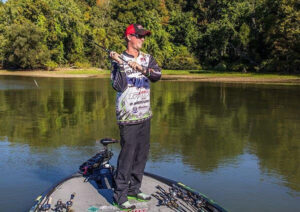As the fall shad migration reaches full-swing in many parts of the country, fishing with soft jerkbaits is an outstanding way to quickly locate quality bass. When the bass aren’t responding to noisy reaction baits, a more subtle approach can lead to an exciting day on the water.
You’ll rarely see Elite Series pro Jonathon VanDam fishing the autumn months without a soft jerkbait within reach. Not only does he catch quality bass with this technique, ”it also allows him to quickly eliminate unproductive water.
An all-terrain alternative
Hard reaction baits will certainly catch plenty of bass, but what happens when the larger bass seek shelter in thick, shallow cover? These areas aren’t conducive to large baits and treble hooks, which forces VanDam to adapt his approach.
“The great thing about soft jerkbaits, such as the Strike King KVD Perfect Plastic Caffeine Shad, is you can put them just about anywhere without the worry of hang-ups,” VanDam said. “On a weightless Texas rig, you can cast to thick
In addition to its weedless properties, a soft jerkbait is extremely castable. Very few anglers have the ability to skip hard baits, leaving heavy cover bass largely unmolested throughout the fall.
“A weightless soft jerkbait skips across the water like a pebble,” VanDam said. “Regardless of your casting skills, you can put these baits into some crazy places. It’s pretty difficult to skip a hard jerkbait under a dock, but a soft jerkbait has the same basic action and can get into the darkest areas of docks where the true giants live.”
Catch fish others leave behind
Schools of active bass aren’t difficult to locate throughout the fall. As they aggressively feed on big balls of shad, they blow their cover by busting the water’s surface. When you locate a group of schoolers, it’s safe to assume that you’re not the only one.
“It’s hard to have a school of fall bass to all to yourself,” VanDam said. “But soft jerkbaits can help you catch fish that other anglers are missing. Most folks will throw a spinnerbait, crankbait or lipless crankbait at these bass, but you can go behind them with a Caffeine Shad and mop up. Its erratic action always seems to fool some of the better ones. These schools get educated, so it’s important to show them something different.”
VanDam utilizes a Caffeine Shad in specific areas this time of year. Instead of focusing on main lake cover, he focuses heavily on the 2 to 6-foot depth range. It’s very possible to catch good fish simply fan-casting, but he has his best luck in areas adorned with a few specific characteristics.
- Backs of pockets—“I love targeting small, main lake pockets during the fall,” VanDam said. “The shad are all making their way to these types of areas and there will almost always be a large concentration of bait present. The bass care more about the bait than they do cover in the fall, so if you find shad, you’ll find bass.”
- Grass lines—“Any type of vegetation lines, whether it’s thicker grass or sparse weeds, will definitely help your cause,” VanDam said. “Ambush points are key, and big bass will hide just inside these lines, waiting to attack shad that pass by.”
- Feeder creeks—“Feeder creeks are very important during the fall,” VanDam said. “When it rains, these creeks will give a little more color to the water and the baitfish will get up there and feed on the nutrients from the runoff. I also think the presence of moving water keeps the water temperature more stable, which is also a positive sign.”
- Gravel—“If you’re on a fishery that hosts smallmouth bass, you can’t go wrong with gravel,” VanDam said. “They love that good, hard bottom and constantly cruise gravel flats waiting for shad to show themselves. You’ll often find yourself sight fishing for fall smallies on gravel flats.”
- Dark spots—“Dark spots can really be anything, stumps, bigger chunk rock or even a big bass sunning itself,” VanDam said. “Basically, dark spots are anything ‘different’ from the surrounding bottom composition and irregularities play an important role in fall fishing.”
Focus on your retrieve cadence
There’s no need to get too bent out of shape about your retrieve cadence, but it is important to pay attention to what the bass are ‘telling’ you. VanDam uses a few, simple tips to draw more reaction strikes from fall bass.
- Start with this—“When I first start throwing a Caffeine Shad, I like to fish it like I would a standard jerkbait,” VanDam said. “Just twitch your rod tip downward a few times, pause it and let it sink for a few seconds before starting your
- If the bass are active—“If the bass are more active and you can see them feeding on the surface, speed your cadence and skip the Caffeine Shad across the surface,” VanDam said. “After it skips a few feet, kill it for a second and you should get some nice bites. You’re going to be looking strictly for reaction bites.”
- If the bass are inactive—“When the fishing is slow, your presentation needs to be slow as well,” VanDam said. “You’re looking to imitate a dying or wounded shad, so twitch less aggressively and let it fall through the water column for a few seconds. This will appeal to fat, lazy bass much more than a fast retrieve will.”
Use correct casting angles and watch your line
Proper casting angles are essential to keeping your soft jerkbait in the most productive strike zones. Remember, VanDam is targeting the 2 to 6-foot range, so he avoids making perpendicular casts to the bank.
“I almost always make 45-degree casts to the bank,” VanDam said. “I’m not specifically targeting bass sitting in deeper water, I’m looking for shallow, active bass. A 45-degree angle lets me concentrate my efforts in my key depth range.”
Regardless of the level of bass activity, it’s essential to be a ‘line watcher’ when fishing a soft jerkbait. There will be times when you’ll see them boil or flash on your bait, but don’t count on that to detect all of your bites.
“When you’re working your soft jerkbait slowly, you’re not always going to see them eat it,” VanDam said. “Many times, you’ll start to jerk your rod tip and feel a bass on the other end of your line. This can lead to awkward hooksets at times, so make sure to watch your line. A lot of your bites will come on the fall, so keep an eye out for any jumps or twitches in your line. If you see this, set the hook immediately.”
Color selection doesn’t need to be complicated
VanDam doesn’t get too carried away when selecting the proper color for his soft jerkbaits. Instead of rifling through compartments, looking for crazy colors, he has developed ‘groups’ of colors for specific conditions.
- Sunny—“Sunny conditions call for your most natural colors,” VanDam said. “I primarily use KVD Magic and Ghost Shad-colored Caffeine Shads under bright skies. They’re more translucent than other colors and won’t spook bass in. Why a Caffeine Shad? According to VanDam, the Caffeine Shad has a much higher salt content than many other soft jerkbaits. This increases its castability and allows it to fall straight down instead of to the side.high-visibility conditions.”
- Cloudy—“In cloudy conditions, you need to be using matte colors,” VanDam said. “Bass can’t get a good bead on translucent colors when it’s cloudy, so you want to select colors such as Pearl or Glimmer Blue.”
- Lack of shad—“Not every fishery has a solid population of shad,” VanDam said. “On many northern lakes, perch and bream move shallow in the fall, much like shad do. This is when you want to use your green colors such as green pumpkin or watermelon.”
- Too much shad—“When you’re around millions of shad, it can be hard to differentiate your bait from the real thing,” VanDam said. “If I’ve got too much ‘natural competition’, I’ll add a little chartreuse to a translucent color to make it stand out a little more. You still want it to look natural, so don’t make it too obnoxious.”
Instead of digging through your tackle boxes wondering why a school of bass has shut off, try throwing a soft jerkbait this fall. Not only can you catch schooling fish with this technique, but you can pick off a lot of bass in-between schools as well.













